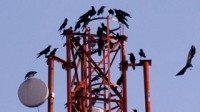
Wildlife biology research determined in the past decade that migratory birds appear to be particularly attracted to or are not threatened by non-flashing red tower lights, eturbonews.com reported. The research concluded the birds are drawn toward that type of light and become confused and exhausted or collide with the towers and their supporting guy wires, killing thousands of birds every year. Several years ago, wildlife organizations, the telecom industry, and FCC collectively asked the FAA to consider changing its lighting standards to reduce migratory bird fatalities by developing configurations that feature flashing lights instead of steady-burning lights, or completely omit the steady-burning lights in some cases, noted the news site.
In the wake of the changes, the FAA conducted flight tests in northern Michigan to compare the traditional steady-burning lighting with a variety of different types of flashing lights. The agencies found the new configurations featuring flashing lights provided acceptable warnings for pilots and were likely to result in a significant decrease in bird fatalities. Base on that, the agency last December updated its Advisory Circular (AC) for obstruction marking and lighting. New tower lighting schemes should now follow the revised guidance, and operators of towers with the old lighting system should submit plans explaining how and when they will transition to the new standards.




Reader Interactions